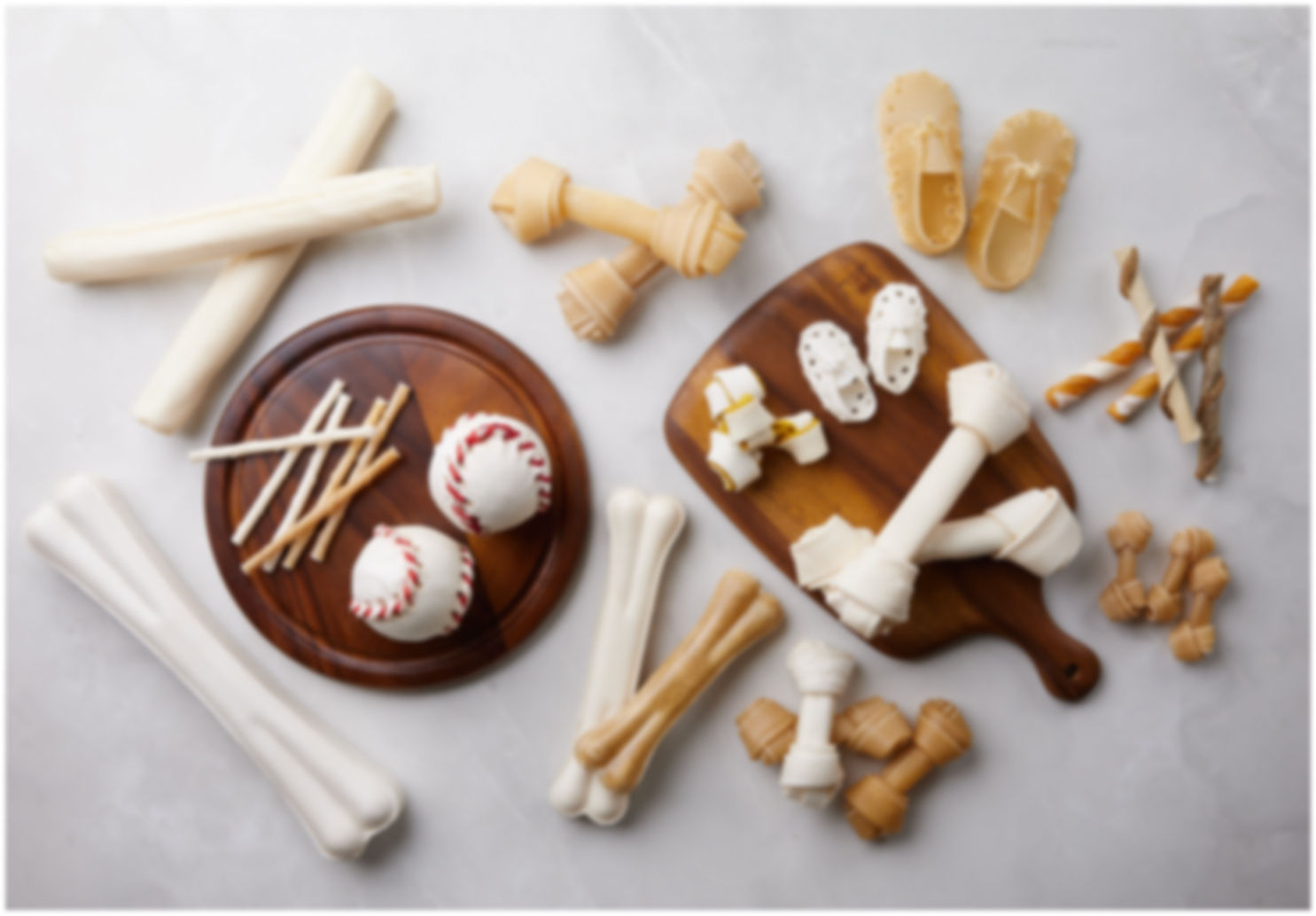

Treats & Tips

History of Dog Treats
Dog treats have come a long way over time. In the past, dogs were fed table scraps, like bones and meat leftovers. The first commercial dog biscuit was created in the 19th century by James Spratt, an American businessman. He got the idea after seeing dogs eat hardtack (a type of dry bread) in England. Inspired, he made the first dog treat using wheat, vegetables, and meat byproducts.
Since then, the pet food industry has grown, offering treats designed for different breeds, sizes, and dietary needs.
The Rise of Chews
Rawhide became popular in the mid-20th century as a
long-lasting chew that helps with dental health. Made from cow
or horse hides, rawhide satisfies a dog’s natural urge to
chew. Over time, improvements in processing have made rawhide
safer and healthier.
A newer alternative is collagen chews, which offer similar
benefits but are easier to digest. Collagen chews support
joint and skin health because they are broken down into
smaller proteins, making them ideal for dogs with sensitive
stomachs.
Expanding Choices
Today, there are more options than ever, including:
- Bully sticks – natural, protein-packed chews
- Nature’s chews (Sweet potato chews) – a healthy, plant-based option
- Exotic chews – made from unique ingredients
- Milk chews – nutrient-rich and long-lasting
Choosing the Best Chews
Whether rawhide, collagen chews, or natural treats, these options help with dental hygiene, chewing instincts, and nutrition. The key is to choose high-quality treats from responsible sources to ensure your dog gets a safe and enjoyable chewing experience.
Rawhide CHEWS
What is Rawhide?
Rawhide is made from the inner layer of animal hide, typically from cows. It is cleaned, cut, and pressed into various shapes to create chewable treats for dogs. These chews help satisfy a dog's natural instinct to chew and promote dental health by reducing plaque and tartar buildup.
Different Types of Rawhide
- Bovine rawhide: The most common type, long-lasting
- Buffalo rawhide: Higher in protein, ideal for dogs with beef allergies
- Pork rawhide: Softer texture, better for small breeds
Rawhide Myths
There has been widespread concern about rawhide due to misinformation regarding its production and potential risks. Here, we address and clarify some common misconceptions:
Myth 1: Rawhide is Made with Toxic Chemicals
- High-quality rawhide is processed using water, natural enzymes, and minimal preservatives. While some low-grade products may contain chemicals, reputable manufacturers follow strict safety guidelines and avoid harmful additives. Look for rawhide that is free from artificial bleaching agents, toxic glues, and unnecessary preservatives.
Myth 2: Rawhide is Colored with Artificial Dyes
- Some cheap rawhide products may use artificial dyes to enhance color, but premium rawhide retains its natural color and texture without synthetic enhancements. Always choose rawhide from manufacturers that maintain transparency about their ingredients and processing methods.
Myth 3: Rawhide is Glued Together with Harmful Adhesives
- Quality rawhide is made from a single sheet of natural hide, not glued-together scraps. If a product contains glue, it is likely a lower-quality variant. Always inspect the labeling and opt for rawhide that is produced under strict quality control and natural binding methods.
Myth 4: Rawhide is Inherently Dangerous and Indigestible
- While rawhide is not fully digestible like some softer chews, it breaks down over time when chewed properly. Dogs should always be supervised when chewing rawhide to prevent swallowing large pieces. Providing an appropriately sized rawhide chew reduces choking risks and ensures safe consumption.
Myth 5: Rawhide Contains Bleach and Other Harmful Preservatives
- Some mass-produced rawhide undergoes aggressive chemical treatments. However, reputable manufacturers use safe, food-grade methods for cleaning and drying the hide, ensuring that no harmful residues remain.
How to Choose High-Quality Rawhide
Look for rawhide that is:
- Made from a single, thick layer rather than multiple thin pieces glued together.
- Free from artificial flavors, colors, and chemicals.
- Manufactured under strict quality control and sourced from reputable suppliers.
The Benefits of Rawhide
- Supports dental hygiene by scraping off plaque.
- Free from artificial flavors, colors, and chemicals.
- Satisfies natural chewing instincts in a safe and controlled way.
When purchased from a trusted source and given under supervision, rawhide remains a valuable chew option for dogs. Always select rawhide products from ethical manufacturers who prioritize safety, quality, and transparency in their production processes.
ALTERNATIVE DOG CHEWS
If rawhide isn’t the right fit for your pup, there are plenty of alternative chews and treats available! From collagen-based, starch-based chews to natural fruit and animal-based chews, there’s something for every dog’s preference and health needs.
Collagen Chews
Collagen chews are made from the inner layer of animal skin, offering a highly digestible and nutritious alternative to rawhide. These chews break down easily in a dog's stomach while promoting:
- Joint and muscle health by supporting cartilage regeneration.
- Stronger skin and coat due to the natural collagen and amino acids.
- Long-lasting chew satisfaction without the risks of brittle splintering like bones.
Collagen chews come in various forms, including collagen sticks, pressed collagen rolls, and braided collagen chews, providing variety while ensuring nutritional benefits.
Treats
Treats differ from chews in that they are often starch-based, allowing for versatility in ingredients and shapes. These treats can be formulated with:
- Superfood ingredients such as blueberries, turmeric, or flaxseeds for additional health benefits.
- Seasonal and festive designs, making them visually appealing and fun for special occasions.
- Custom shapes and textures, including soft-baked, crunchy, or jerky-style options, catering to different dog preferences and dietary needs.
Nature’s Chews: Fruits and Exotic Animal Parts
Natural chews sourced from fruits and animal parts provide unique textures and flavors while offering excellent health benefits. Some of the best options include:
Fruits and Plant-Based Chews:
- Coconut Chips: Provide healthy fats that boost skin and coat health.
- Sweet Potato Chews: A great low-fat option packed with fiber and beta-carotene.
- Banana Chips: A natural source of potassium and fiber, ideal for digestion.
- Carrot Chews: Low in calories but high in fiber and beta-carotene, great for vision and digestion.
- Pumpkin Chews: Packed with fiber, vitamins A and C, and known for promoting digestive health and firm stools.
Exotic & Animal Part Chews:
- Chicken or Duck Feet: High in collagen and great for dental health.
- Duck Heads: A crunchy, calcium-rich treat that offers a natural source of nutrients while promoting dental health.
- Beef/Pork Trachea: Contains natural glucosamine and chondroitin for joint support.
- Beef Ears: A softer alternative to pig ears, suitable for small or senior dogs.
- Beef Tendons: A chewy, protein-packed option that helps clean teeth naturally.
- Fish Skins: A lightweight, crunchy chew packed with Omega-3 fatty acids to support brain function and a healthy coat.
- Whole Fish (Dried): A nutrient-dense chew that provides protein, Omega-3s, and natural calcium from bones.
DOG-TREAT Compatibility Tips
There’s no universal “best treat”—it’s about what suits your dog’s breed, lifestyle, and needs! Like humans, dogs have different tastes, chewing habits, and dietary requirements. The goal is to discover what delights them while ensuring they stay healthy and happy!
Choosing Treats Based on Breed & Chewing Style
- Small Dogs (Chihuahuas, Dachshunds, Pomeranians): Soft chews, small bites, or collagen sticks.
- Large Dogs (Labradors, German Shepherds, Golden Retrievers): Tougher chews like thick rawhide, yak chews, or beef tendons.
- Giant Breeds (Great Danes, Mastiffs, Saint Bernards): Extra-large rawhide bones, knuckle bones, or durable collagen chews.
Balancing Treats with Calories
- Light Snackers (Couch Potatoes or Seniors): Low-calorie treats like freeze-dried meats or air-dried veggies.
- Active Dogs (Daily Walkers & Adventure Seekers): Protein-packed treats like bully sticks and meat-based biscuits.
- High-Energy Dogs (Working & Sporting Breeds): High-calorie yak chews, rawhide, and functional treats with extra nutrients.
Treats for Every Life Stage
- Puppies (Under 6 Months): Teething treats like yak chews, soft dental sticks, and training bites.
- Adult Dogs: Durable chews like rawhide, collagen sticks, and interactive treats for mental stimulation.
- Senior Dogs: Soft, easy-to-chew options like lamb ears, dental sticks, or low-calorie biscuits to support aging teeth and joints.
Dietary Considerations & Health Benefits
- Grain-Free Diets: Single-ingredient treats like dried meats or exotic chews.
- Weight Control: Low-calorie chews like dehydrated vegetables.
- Joint Support: Treats enriched with glucosamine and chondroitin.
- Dental Health: Textured chews like dental sticks or rawhide twists to reduce plaque.
General Treat Safety Tips
- Always choose a chew size larger than your dog’s mouth to prevent choking.
- Monitor for signs of digestive issues, such as excessive drooling, vomiting, or diarrhea.
- Supervise treat consumption and discard small, broken pieces.